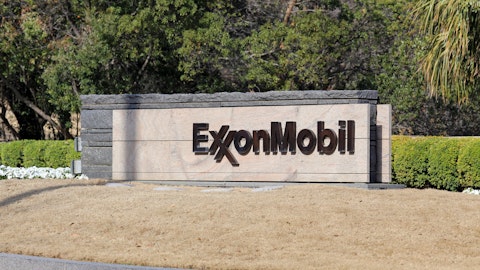Torgrim Reitan: Okay. Thanks, Alastair. So, on renewables and supply chain commitment. So, let me talk to the situation in the U.S. So, the impairment that we have done is $300 million, as I said. We have now still $100 million in book value in sort of the two assets. And in addition to that, we have $200 million books related to real estate in New York and some equipment, which is in reality cables. Beyond that, we have commitments, that is not sort of booked, but we still have them. They are mainly related to a lease arrangement to a property in Brooklyn, as such, which is a lease that and a property that can be used for other purposes. And we have also contracts related to ships and turbines, which are typically, can be used other places in the portfolio as well.
But I mean, it’s too early to give specific numbers on those, but that is sort of the exposure as such. So, in addition to that, we have a termination fee to the current offtake contract, which is at $16 million as such. So, I think that gives sort of the totality of the exposure at hand. And again, sort of we are welcoming the process that the New York State now is starting. And we will work closely with them to see what sort of opportunities that can arise out of that. On, gas demand, yes. I mean, storages are for practical purposes for the time being. But clearly, we see a very tight market and a rather nervous market, where sort of small, not small, but where happenings have typically a significant impact on prices. We have seen it on the terrorist attack on Israel.
We have seen it on the pipeline, the Baltic pipeline and we see quite a bit of volatility in the prompt particularly. So, I think we just need to be prepared for a rather volatile and tight situation through this winter. Weather will, of course, always be a significant thing, and, as well, demand from Asia. Demand is sort of I mean, in demand from industrial customers are not really coming back to pre-war levels, but it is still sort of a helps the demand also from the industrial segments as I see it.
Bard Glad Pedersen: Next one is Henri Patricot from UBS.
Henri Patricot: Two questions, please. Just first one, I wanted to ask about M&A. We’ve seen there could be a full consolidation in the U.S. upstream lately and we’ve seen changes in renewables. So, I was wondering whether these recent developments are changing in a way your potential appetite for M&A and then your focus in terms of, where you like to make acquisitions in the future, in terms of region, but also between upstream and renewables? And then secondly, I wanted to ask about the CapEx. So, you mentioned that you see CapEx for this year more in the lower end of the guidance range. Can you expand on what’s driving CapEx toward the lower end for this year and whether you see risk a bit to the downside as well for the next few years or if there is just inflationary pressure and, risk may be more to the upside?
Torgrim Reitan: Thanks, Henri. So First on M&A. So, I mean, the two large acquisitions in the U.S. clearly sends some signals to the market, one that is that sort of oil and gas to be attractive for a long period as such. And also, I think there is an element of energy security importance as well, that is sort of driving that. So, I don’t think it’s unlikely that we will see more transactions of also bigger size going forward but this time, it is a little bit different than last time around. Last time around, it was driven by a low-price environment and cost synergies and efficiency. This is not a driver this time around, there are different drivers. So, I think what this will lead to is more uncertain this time around. So, we will have to follow that closely.
But we have, when you talk, our portfolio as such, I mean, it is a strong portfolio within oil and gas already. I mean, we are growing towards 2026, and we will keep the same level all the way to 2030. And we have an average breakeven of $35 per barrel and internal rate of return on 30% of these projects. So, it is a good investment program going forward. When that is said, I mean, we are using M&A actively as a tool. And you have seen it last year. We have made an acquisition into oil and gas, the Suncor portfolio in the UK, and you have seen several acquisitions within the renewable space as well. Rio Energy, BeGreen in Denmark. So, we will continue to use M&A actively to focus and deepen our oil and gas activities and to support the energy transition, and building a new portfolio.
So, I mean, we will do that. And then, it is very important for me to say that capital discipline is front and center when doing M&A. Timing is of essence and quality is of essence. Your second question on CapEx. So, the reason for that we will come towards the lower end of the guiding this year is phasing of projects. So, these are spending that typically will move on to later years. When it comes to from 2024 and onwards, we are in the midst of our planning season. We are prioritizing among a set of very attractive investment opportunities. There is competition for funds. So, we are in the midst of doing that. I think it’s fair to say that we will continue to demonstrate capital discipline. And then, of course, we note that there is inflationary pressure in the portfolio, which is particularly linked to the non-sanctioned part of the portfolio.
But we are managing this well, and we will come back to this on the Capital Markets Day in February.
Bard Glad Pedersen: Next question is Kim Fustier from HSBC. Kim, please go ahead.
Kim Fustier: Hi, thanks for taking my question. My first question is on the low-carbon solutions. I think you recently bought a 25% stake in Chevron’s Bayou Bend CCS project in the U.S. Gulf Coast. Could you just talk about the development timeline and about what Equinor is bringing to the consortium? And secondly, it seems that there’s some controversy from environmental groups in Norway with respect to new NCS developments, including Breidablikk and Yggdrasil. Could you comment on the operating environment in Norway? Could things maybe become more difficult going forward if these environmental groups gain more traction? Thank you.
Torgrim Reitan: Okay. Thank you, Kim. So, you’re right. We made an acquisition, into Bio Band in Texas. That’s a storage carbon CCS project and then storage. Chevron is operator, and we now sit on 25% on that lease. So, this is a reservoir of very high quality, and with potentially significant capacity to store CO2, I mean benefiting from the IRA regulation. So, we are enthusiastic about that opportunity. We typically bring quite a bit of experience when it comes to reservoir management and understanding of capacities and how to do this. And we have a long experience working together with Chevron in the Gulf of Mexico, also particularly working on the reservoir topics together with them. So, we see that as a clear and then, we shouldn’t forget that, we have more than 30 years of experience on CCS from the Norwegian continental shelf through our experience on Slater [ph] and also on some other fields as well.
Your second question on the sentiment in Norway for future developments. It is clear, there is, there is opposition in Norway as well as in other places. I would say there is a politically a very strong and good consent and collaboration across political landscape to support the development of the Norwegian continental shelf. So, I feel confident that this is an area where investing into oil and gas is giving a predictable and a stable environment as such. And then there will always be institutions and voices that are against what we do, and we need to treat that with respect and openness. And clearly, we are in dialogue with everyone as such. So, I don’t find it to be any particular concerns in Norway compared to other places.
Bard Glad Pedersen: Next question is Peter Low from Redburn. Peter, please go ahead.
Peter Low : Just a question on the balance sheet. It remains firmly net cash. You’ve talked in the past about wanting to return to that 15% to 30% leverage ratio, perhaps distributions being something that will kind of get you there. As we begin to think about 2024 shareholder distributions. Can you give us any insight on kind of how quickly you’d like to get back to that level of change? And then the second one was just very quickly, you mentioned the impairment you’ve taken on the NCS due to, I think, an asset, having kind of a lower reserve estimate a previously, and then also reverse development impairment in the U.S. Are you able to name those assets and say what led to that change in assessment? Thanks.




